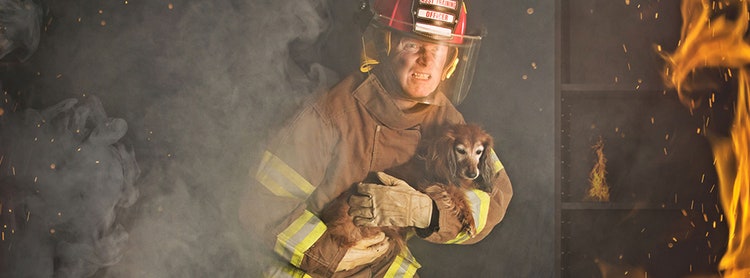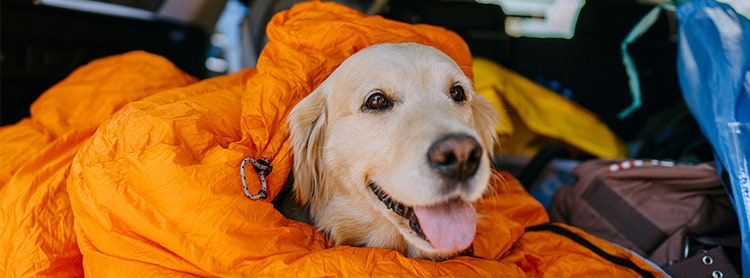
Disaster preparedness for pets: Top tips for emergency situations with your dog or cat
From waking unsuspecting family members during a spreading housefire, to detecting the onset of an epileptic seizure, we’ve all heard incredible stories of pets heroically swooping in during an emergency and saving the day. But what happens when disaster strikes and they need your help? Your beloved pets are relying on you to keep them out of harm’s way, no matter what the scenario is, and these days, we need to be ready for whatever Mother Nature has to throw at us. With some advance preparation and basic but essential supplies, pet parents can calmly ensure the safety and well-being of their pets in any situation. Follow these disaster preparedness tips for pets to ensure your family is ready before, during and after a catastrophic event.
How to prepare for disaster before an emergency
The first step of your plan is, well, to have a plan. This includes preparing your pet for emergencies ranging from short term evacuations, to all-out catastrophes. With your plan confidently in place, you can remain calm and keep those around you calm too.
- Stock up - ensure you have everything your pet will need with a well-stocked pet emergency supplies kit , including:
- all required medications
- food (stored in an airtight container and regularly checked for freshness)
- water (and metal bowls)
- a spare collar, leash and/or harness with up-to-date ID tags. 24Petwatch’s Lifetime Warranty ID Tags offer customization with your pet’s name and microchip number and come with a lifetime warranty (if damaged or unreadable)
- up-to-date copies of vaccination and medical records
- a travel carrier or crate (large enough for your pet to stand, turn around in and lie down)
- appropriate litter space or waste bags
- pet first aid kit
- grooming and cleaning products
- comfort items (blankets for warmth and a favorite toy)
- a family photo including your pet in case of separation
- contact information for your family and vet
- your pets' feeding schedules, medical conditions and behavior issues in case you have to board your pets or place them in foster care.
Large kits are ideal for sheltering in place, while smaller kits are ideal for evacuations.
- Practice makes perfect – trial runs of your family’s emergency evacuation plan so everyone understands their role will ensure smooth sailing when or if it’s actually needed. Know your pets’ favorite hiding places in case they get spooked so you can find them quickly and know how to lure and catch them. Practice getting them into and transporting them in their crate as well, especially if they are not used to carriers.
- Know where to go – whether you’re fleeing an active wildfire, or hunkering down at a disaster-relief zone, knowing where to go is key to remaining poised in the face of a panic-inducing scenario. Be aware of pet-friendly hotels/motels in your area, and inquire if no-pet policies at other establishments are waived in emergency scenarios or for service animals. If friends, family or neighbors are trusted options to watch your pets for you, ensure they are aware that they will be the first one you call for assistance with watching your pet. In case internet service is unavailable, printed copies of a list of nearby vet clinics, pet supply stores and pet-friendly lodging should go into your pet emergency preparedness kit. Contact local/municipal emergency offices, shelters, animal control and veterinary hospitals to ensure you know all of your options.
- Microchip your pet – all pet owners should strongly consider microchipping their pets, whether disaster strikes or not. Research shows that microchipped dogs are more than twice as likely to be reunited with their families, while microchipped cats are returned 20 times more often. And, with our Lifetime Protection Membership, 24Petwatch reunites more than 3,000 lost pets with their owners every month.
- Prepare for a possible emergency evacuation due to fire by printing or purchasing an ‘Animals Inside’ sign/sticker, indicating how many pets (and which types) are in the home and place it in a window or highly visible location outside the home. These are a quick and effective way to alert fire rescue teams that there are animals in the home that require evacuation.

In the thick of it – how to care for your pet during a disaster
If you’ve followed the tips above and have prepared your dog or cat evacuation kit, done your research and microchipped your pet, you’re already ahead of the game. Now you can focus on keeping your family safe and composed during any emergency scenario.
- If it’s safe to do so, bring all pets indoors immediately and ensure they’re wearing their collars with proper ID tags, like 24Petwatch’s Lifetime Warranty ID Tags. Leashes should also be nearby ready to go.
- Pay close attention to local news sources, but don’t wait for a mandatory evacuation, especially in the case of flood or wildfire. If it’s not safe for your family, it’s not safe for your pets. Knowing how to safely evacuate your dog or cat is critical. Depending on the crisis, assume that you won’t be able to return to your home anytime soon – DO NOT leave your animals in the home if you need to leave. Pets left behind in a disaster can easily be injured, lost, or killed.
- If you’re able to stay safely in your home through a tornado or hurricane, retrieve your pet emergency kit and move the family to one common ‘safe zone’ area in the home. Block any hiding places where scared cats and small dogs may go so evacuation can occur quickly, if necessary.
The calm after the storm – how to recover from a disaster with your pets
Okay. You can breathe. Fingers, toes and paws have all been accounted for. Now it’s time to (literally and figuratively) pick up the pieces. Remember, just because the fire is out or the eye of the storm has passed, it doesn’t mean the coast is clear.
- Keep animals leashed upon returning to the home to asses the damage following a disaster to avoid your pet panicking and running away. Your pets may be scared and disoriented with many unfamiliar smells in their home, in addition to being at risk for injury depending on damages, including exposed wires, broken or damaged furniture or large items, spilled chemicals and more. Ensure exterior fences and gates are still secure and block any openings that pose an escape risk if your pets go outside.
- If your pet has any minor injuries, treat them with your pet first aid kit, and seek veterinary assistance as soon as you are able.
- If you suspect a broken bone, stabilize the limb with something sturdy like a rolled-up magazine and gently secure it with rolled gauze or elastic wrap. Be careful not to restrict blood flow by wrapping the injury too tightly
- If treating an open wound, clean the area with water or an antiseptic solution and gauze and secure a bandage – do not apply any ointments to open wounds until a veterinarian has examined your pet
- Cover your pet with a towel or blanket to keep them feeling secure
- If you know your pet is prone to biting or fighting against this type of care (do they let you clip their nails, normally, for example?), you may want to include a muzzle in your pet emergency kit so you’re able to treat their wounds without risk of being hurt yourself
- If your pet has a fall - look for signs of internal bleeding, including pale gums, collapse, bleeding from nose or mouth or coughing up blood. Seek veterinary attention immediately if these signs occur
- If your pet has a minor burn, apply a steady stream of cool water to the injury, followed by a cold compress for 10 minutes. For chemical burns, wear rubber gloves to avoid transfer to your skin, remove any collars or accessories that may have come into contact with the chemical and rinse the area with cold water for 15-20 minutes. Cover the burn with a non-stick bandage and seek veterinary assistance. Second- and third-degree burns require immediate veterinary assistance

What to do if your pet is lost
If your pet has gone missing during the chaos, here is what you need to do:
- First things first: Contact 24Petwatch and report it immediately. One of our Lost Pet Recovery Specialists will get to work searching our nationwide database of found pets and start the recovery process
- Contact your local animal control facilities, shelters, your vet and any vets you may have been near when your pet went missing to report the loss of your pet. Provide photos and ensure all organizations know if your pets are microchipped as this will greatly improve your chances of being reunited with them
- If you’ve returned to your home without your pet, check every corner of your home anyways. Oftentimes, pets will make their way back home on their own and could be in one of their favorite hiding spots, scared, waiting for you to find them. Patrol the area surrounding your home, street and neighborhood several times a day, and enlist neighbors and friends for help
- Lost pets can become disoriented even when relatively close to home. To help them find their way back, place beds, litter boxes, and toys with familiar scents in your yard. Avoid leaving out food, which can attract other animals and actually scare off your pet
- Spread the word with posters, social media posts and missing pet boards and via family and friends. Be sure to include a photo of your pet with your phone number and any specific instructions related to your pet’s behavior, such as “do not chase”, in case they are spotted. It’s also a good idea to ensure posters are inserted into water-proof coverings
- Help reduce the chances of lost pets in the future with proactive steps to ensure the safety and wellbeing of your pet, such as securing outdoor areas, conducting regular training exercises and microchipping your pet. You can also purchase Lifetime Protection Membership from 24Petwatch for the greatest chance of recovering your pet in the event it goes missing
Pets are part of the family, so it’s crucial to have a plan in place for them should there ever be an emergency or disaster situation. By staying calm and with the tips outlined above, you'll have the best chance at keeping your beloved pet(s) happy, healthy and by your side for many years to come.